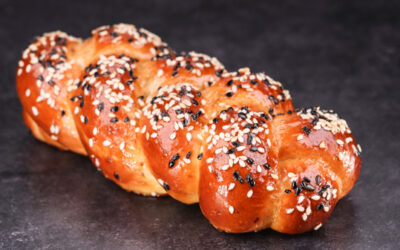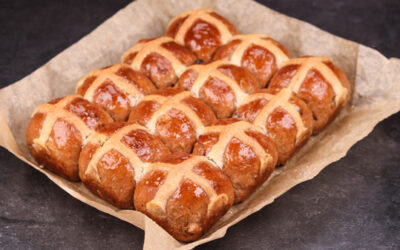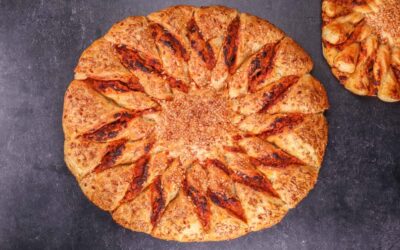I love finding out about unique festive breads from all over the world. This casatiello is certainly that. A huge bread filled with meat and cheese and topped with whole eggs.
Traditionally the bread is prepared on Good Friday and left to slowly rise overnight and then baked on the next day. It is commonly filled with cured meats like salami and pancetta and cheeses like scarmoza, pecorino, parmesan, or provolone.
The shape of it is achieved by baking it in a special pan which is by no means necessary. As I show in the video a little bit of improvisation is all that is needed.
This recipe has been adapted to fit my style. but I have kept the basic principle of this bread and made it my own.
I have seen several versions of it, so who knows which one is the proper one. There is one thing that I left out only because I forgot about it – black pepper! It must be added to the dough. So, if you want the flavour in there, then go ahead and add about 3g of freshly ground black pepper to the mix. Saying that, the salami I used was quite peppery.
There is another unique Italian Easter bread that had a whole raw egg placed in it for baking – Pane Di Pasqua. You can find it in the Breads of Easter playlist on my channel.
Watch the video down below for detailed instructions.
Ingredients
For the dough –
400g (14.1oz) white bread flour
30g (1oz) olive oil
6g (0.21oz) salt
6g (0.21oz) instant dry yeast or 7.2g (0.25oz) active dry yeast or 18g (0.63oz) fresh yeast
240g (8.45oz) water*
*To learn more about dough temperature control click here.
3g (0.1oz) ground black pepper
For the filling –
250g (8.8oz) diced provolone cheese
60g (2.1oz) grated parmesan
180g (6.3oz) diced Neapolitan salami
120g (4.25oz) diced pancetta
To top –
4 whole raw eggs, washed, dried, and kept at room temperature.
1 egg for brushing
Method
- In a large bowl combine the water, yeast, salt, pepper, and oil. Mix well to dissolve the salt and hydrate the yeast. Add the flour and mix to a dough.
- Tip the dough out on the table and knead for 7 minutes. *Desired dough temperature 25C – 26C (77F – 79F). If your dough is warmer, then it will ferment more rapidly. If it is cooler, then it will take longer. Adjust proofing time accordingly.
- Remove 80g of dough and leave in a separate bowl. My camera failed at some point, so I have no footage of this. This dough will be for the crosses to cover the eggs.
- Ferment for 1 hour.
- Fold. Both the large dough and the smaller one.
- Ferment for 1 more hour.
- Roll out the larger dough to around 70cm (27in) in length. Sprinkle with the fillings evenly leaving an edge at the top. Roll it tight and seal it up by brushing the loose edge with water. Place in a non-stick paper lined cake ring. The one I use is a 25cm (10in) cake ring. *At this point divide the smaller dough into 8 equal pieces and shape into little balls.
- Cover everything and leave for the final proof which should take around 2 – 2.5 hours. You really want this to rise well otherwise it will be dense. *During the final hour of proofing preheat your oven to 180C (3550F) fan off.
- Wrap the eggs. Roll out two dough balls at a time and wrap them around the egg to make a cross. Seal up at the bottom of the egg.
- Brush the loaf with egg and place the dough-wrapped eggs on it. Jam the eggs deep into the loaf, but don’t go too crazy as to not break them! Lastly, brush the crosses with egg too.
- Bake for 60 minutes. Turn the loaf, if need be, to get an even bake.
Leave to cool down and enjoy! Happy Easter ?
Keep in mind that the conditions in each kitchen are different, so fermentation times may vary for you. It is up to the baker to control the bread and react accordingly.
Your oven may be different too, so your baking time may vary.
Watch the video here



